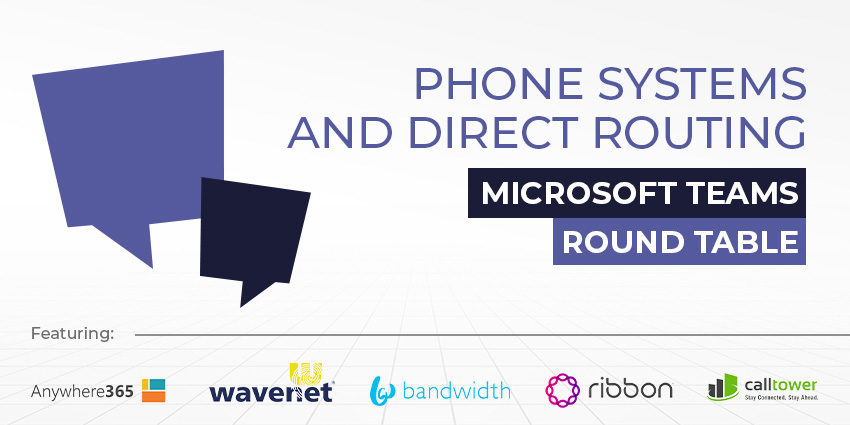To Direct Route or not to Direct Route? That is the question for many organisations, regardless of size.
Since many businesses have been forced to work remotely for over a year, Direct Routing has exploded in popularity. However, Teams also offers Calling Plans, but they are limited by several factors, including geography and cost.
As hybrid working looks to become the post-pandemic ‘new normal’ many businesses are weighing up the benefits of Direct Routing as a long-term solution for a distributed workforce.
We sat down with Teams experts from CallTower, Ribbon, Anwhere365, Bandwidth and Wavenet to discuss the pros and cons of Direct Routing versus Calling Plans and what size of organisation stands to benefit the most from it.
Why is Direct Routing so popular vs Microsoft’s own calling plans?
It is a simple question, why would you opt for a third-party solution when the vendor has calling capabilities integrated into the platform? According to our industry experts, there are many facets to Direct Routing that makes it a more attractive option to businesses, including its ubiquity, cost-efficiency and ease of use.

Gijs Geurts, CEO of Anywhere365, highlighted the fact that Calling Plans is only available in a small number of countries, while Direct Routing is available everywhere is more customer-friendly. He said it provides enterprises with greater control and value and lets them work directly with their preferred carrier, including fail-over control, call forwarding and real-time re-routes – all on the Teams platform.
“It’s also easy maths,” he stated.
“Compare your current telecom costs to the additional cost of Calling Plans, with a dedicated call path for every employee. That adds up pretty quickly, especially in enterprise-size organisations. In Direct Routing you pay for the SIP paths, employees share community paths, and only occupy a path during a call. Enterprises typically save an average of 40 per cent when they choose the Direct Routing option.”

Mike Korkidakis, Wavenet’s Head of Distribution, attributed Direct Routing’s popularity to its broader feature set, diverse integrations, enhanced margins competitive call costs. Typical providers have knowledge and skills in the voice field and have built and paired robust platforms with these advanced feature sets, he said.
It does all this while utilising the benefits of the single Teams interface and the bonus of the native Teams feature set, which of course, is constantly being developed by Microsoft,” he stated.
“It also opens a more tailored support infrastructure as typically Direct Routing providers have dedicated voice support and expertise, allowing that element to be supported by specialists whilst having the benefits of the truly collaborative Teams experience”

Lauren Brockman, Director, Product Management at Bandwidth, listed several factors that are driving the success of Direct Routing, including PSTN coverage beyond the areas covered by Microsoft’s Calling Plans, its ability to integrate with third-party applications, particularly Contact Centre functionality and its flexibility to sunset legacy platforms over time.
“How an enterprise implements telecom for Teams is also highly correlated to company size, and more importantly, their knowledge worker base,” she added.
“For smaller businesses, Calling Plans are still a fantastic option. With all-in-one purchasing and set-up as well as built in management tools, the simplicity makes sense for strained IT departments”
“For larger enterprises, the needs grow more complex; adoption statistics show that over two-thirds of large enterprises choose Direct Routing. We expect this trend to continue with the launch later this year of Operator Connect, Microsoft’s third way to connect to Teams specifically targeted for Carrier BYOC options.”

Greg Zweig, Director of Solutions Marketing at Ribbon, said that Direct Routing’s popularity comes down to cost benefit. Calling Plans can be more cost-prohibitive for companies with over a dozen users and they don’t accommodate transitions from existing kit.
“For organisations with 10 or more users, Direct Routing costs less than Calling Plans, allows organisations to choose their service provider and enables integrations with legacy PBXs. It also integrates with common analog devices that businesses still need such as fax lines, door phones, elevator phones”

William Rubio, Chief Revenue Officer at CallTower, highlighted the “personal touch” provided by Direct Routing providers that customers can’t necessarily get from a large organisation like Microsoft. A provider can offer support and alternatives in the event of a Teams outage, ensuring that clients can still make and receive calls.
“The first thing you’re getting from us is a personal touch and a solid timeframe,” he stated.
“Microsoft tends to roll out their APIs whenever their schedule allows and they leave the onus of the work on the customer to complete themselves. It’s a huge IT burden to manage the network, porting, implementation and training – especially for smaller companies who don’t have a large IT apparatus.”
Is Direct Routing for large and complex companies only or are small businesses and start-ups adopting it too?
Anywhere365’s Geurts believes that Direct Routing is an “easy choice” for multinational organisations because of its flexibility, compared to the limitations of Calling Plans. The latter can be a good option for smaller companies who only operate in one country but it offers limited support, he added.
“Calling Plans may not be available in every country that they operate, so they can’t put all employees onto a globally consistent platform. Some users will miss out on the advantages of unified communications; that’s why larger companies go for Direct Routing,” he explained.
“For smaller companies with limited resources or that only operate in one country, Calling Plans can be a good option, but only if they are in the limited set of countries where Microsoft offers these plans. A thing to consider for them, though, is that Calling Plans are a self-service solution. There’s only limited support and it can be challenging to port phone numbers over from existing carriers.”
Wavenet’s Korkidakis is seeing organisations of all sizes adopting Direct Routing because of that broader feature set it offers at the same price point as Calling Plan, as well as allowing providers to customize features.
“This then means the customisation can be tailored to specific industries or simply to an individual organisation and their unique requirements,” he elaborated.
“This can be anything from delivering bespoke reports over an API that produces relevant information to that business, to fully compliant call recording paired with CRM integrations for regulated organisations in the financial sector. Direct routing offers an extended approach to collaboration and the ability to deliver a bespoke and unique solution customer by customer regardless of size.”
Bandwidth’s Brockman agreed with him, adding that these tailored solutions catering to SMBs are a result of the evolution of Direct Routing and the diversification of the offerings around it. However, she still sees the value in Calling Plans for SMBs.
“Since Direct Routing requires an SBC and a certain amount of technical knowledge around PowerShell, certificates, SIP, E911, SBC configuration, etc, options that provide professional and/or managed services along with low or no-code solutions will begin to remove some of the accessibility barriers surrounding Direct Routing,” she explained.
“That said, start-ups and SMBs should still seriously consider Calling Plans. Value breakage with Calling Plans seems to occur only once an organisation’s need for PSTN calling capabilities surpasses a few hundred employees or seats. Enterprises regardless of size should keep that in mind as they weigh the cost benefit of spending time and resources hunting an alternative solution.”
Ribbon’s Zweig reiterated that the majority of organization with more than 12 users would financially benefit from choosing Direct Routing but agreed with Brockman that its installation can be a challenge for smaller companies.
“The challenge for small businesses with Direct Routing is that they need to buy an SBC, set it up to work with their service provider and configure Teams for calling,” he said.
“SBC vendors like Ribbon try to make that easier with deployment wizards and options to rapidly spin up a software-based SBC in Azure or AWS.”
CallTower’s Rubio has seen both large and small companies adopting its Direct Routing solution and that the continuous growth of Teams allows providers to add value to the core offering through integrations and features.
“Enterprise and small business also like to take advantage of our flexible licensing to customise their usage between people and departments,” he said.
“Microsoft recently announced Teams is the fastest growing environment of integration applications. We’ve been able to achieve CRM integration between Teams and a huge number of applications, plus we’ve got a few features that can only be accessed through our Teams Direct Routing solution.”
Who does a business contact to deploy direct routing? What’s the buying process?
Wavenet’s Korkidakis recommends Direct Routing providers as the first stop for companies considering adopting the service, particularly those who have already adopted Microsoft 365.
“For those organisations that have already adopted M365, the option to enhance the Teams experience by adding in external calling is easy and made simple by direct routing providers,” he elaborated.
“With no changes to the M365 environment, no changes to a tenancy and end-users maintaining their sign-in criteria the rollout is made easier. Organisations like ourselves have focused on automation allowing the direct routing set up to be fully managed, simple and supported throughout the entire deployment, from initial scoping calls to proof of concept and end-user training”
Large enterprises have traditionally purchased their Direct Routing from telecom carriers, but a variety of new players are entering the market targeting the SMB space, according to Bandwidth’s Brockman. These new players range from competitors in the UCaaS space to resellers and systems integrators who are building integrations and add-ons to native Teams functionality. For larger businesses, however, she said that purchasing directly from a carrier still makes the “most sense”.
“Before entering the buying process, look internally to figure out scope and scale of need,” she advised.
“Then, account for the level of outside assistance needed for implementation and ongoing management. That due diligence will give organisations a guiding light when searching for an appropriate solution and partner in the Direct Routing process.”
When deciding on who to contact about Direct outing deployment, a company should consider their requirements for coverage, costs, support, resiliency, uptime and features, in addition to the Teams software, according to Anywhere365’s Geurts.
“When making the move to direct connect, it’s crucial to look for a reliable managed service provider with a proven track record of previous implementations and work as native to Teams as you can,” he said.
“The right certified partner can ensure a successful implementation of Direct Routing for Microsoft Teams by offering system architecture design, system integration, migration, training, support, and more.”
CallTower’s Rubio agreed with this and recommended that companies considering Direct Routing deployment should arrange a consultation to discuss their needs with the partner.
“We find that the consultation is a helpful start to the buying process so our team can discover more about the specific needs of the organisation in question. Once the customer and our team have the scope of the project settled, then the actual contract and implementation phase can begin”
Ribbon’s Zweig recommended any business contemplating adopting Direct Routing to get in touch with an authorised reseller.
“We believe that our customers value the expertise and local presence partners can deliver,” he said.
“If a business does not have an existing partner relationship, we can easily help make a connection. We have partners all over the globe that are trained and ready to support any size organisation.”







